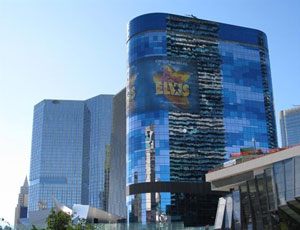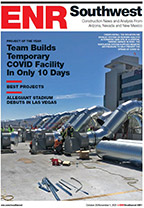The still unopened Harmon Hotel, a 27-story centerpiece of the now financially hemorrhaging CityCenter development in Las Vegas, is being targeted for demolition. MGM Resorts International, owner of the troubled 67-acre complex that includes the hotel designed by U.K. �starchitect� Sir Norman Foster, recently unveiled plans to raze it. MGM took a $279-million write-down in the third quarter on the building, which sits dormant with a sign wrapped around its gleaming glass fa�ade for the resort�s �Viva Elvis� show. Harmon may be the world�s most expensive billboard.

Part of Harmon�s problems stem from an ongoing bitter lawsuit between MGM and its general contractor Perini Building Co. over construction defects, among other things. Harmon has "substantial defective construction" resulting in "hundreds of millions of dollars in estimated damages," MGM�s lawsuit claims. Harmon�s problems are fixable, says Perini President and CEO Craig Shaw, who calls the lawsuit a smokescreen to avoid paying the final construction tab.
Lawsuits and finger-pointing will prevent anything from happening to the tower until late 2012, say MGM officials. Harmon marks the latest in a series of setbacks for the massive CityCenter complex that opened last December. The $8.5-billion development, the priciest private project in U.S. history, lost nearly $1 billion during the first nine months of 2010, including $600 million in write-downs. CityCenter broke ground during the peak of the real estate boom but finished amid a deep recession. As the economy went south, MGM responded with cost cutbacks.
MGM lopped Harmon nearly in half in January 2009 as part of a money saving measure with only half of its original 207 high-end residences on 47 floors sold. The move saved $600 million in construction costs and deferred another $200 million in expenses needed to finish the interior.
�It's clearly stumpy, and that's not good on the most prominent site in the complex,� says architecture critic Alan Hess, author of Viva Las Vegas: After Hours Architecture. �Without a tenant, it also creates a black hole along the Strip sidewalk, with no activity, shops, entries at that point on the link between the Bellagio and CityCenter.�
MGM once had high hopes for Foster�s creation; it gave his oval blue-glass checkered building design prominent Strip-front placement. The Harmon would have marked Foster�s first building in Las Vegas. Today, it stands as a blemish at CityCenter's swirling glass menagerie of homes, hotels and shops, observers say.
Foster reportedly isn�t happy with the outcome of Harmon. A Foster spokesperson refused comment for this story, but the project is no longer listed on the architect�s web site. Foster was also a no-show at the CityCenter opening festivities last Dec. 16, the only major designer who didn�t attend. It marks a major change of direction for an architect who was �thrilled to be designing a new hotel concept,� according to a Foster quote included in CityCenter�s original press material.
�I think that like any good master-plan, when you remove a piece, you are in danger of setting off an imbalance that has repercussions,� says David Baird, architecture school director at the University of Nevada, Las Vegas. �It reduces the density of the development, which is one of the goals of CityCenter.�


Post a comment to this article
Report Abusive Comment